Key takeaways:
- Failures often stem from assumptions rather than data insights, emphasizing the need for audience research and understanding.
- Effective campaigns require clear objectives, flexibility to adapt mid-strategy, and a strong call-to-action to engage the audience.
- Learning from feedback, even when difficult, can enhance future campaigns and foster stronger audience connections.
- Collaboration across teams can provide valuable insights, improving strategy and execution for richer campaign outcomes.
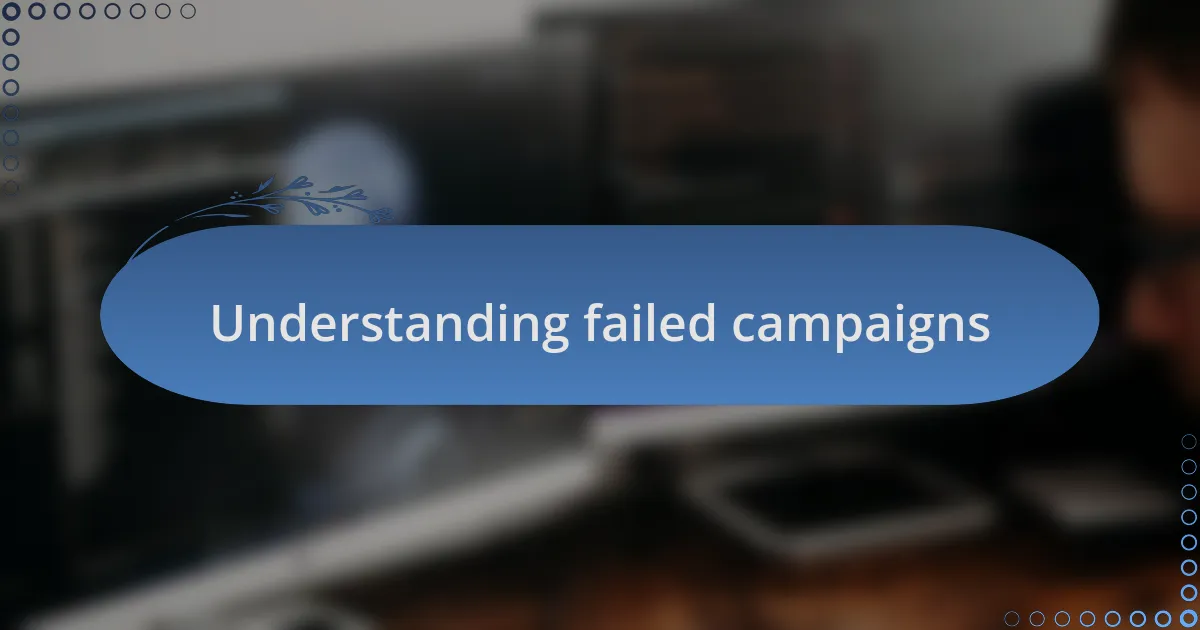
Understanding failed campaigns
Understanding failed campaigns is often a painful yet illuminating experience. I remember a project where we invested significant time and resources, only to realize that our target audience wasn’t engaged at all. It made me question, how had we misread our audience? In retrospect, it became all about assumptions rather than data-driven insights.
To truly grasp the reasons behind a campaign’s failure, it’s crucial to analyze every aspect critically. I’ve faced the disappointment of launching a beautifully designed program that, despite its aesthetic appeal, completely missed the needs of the users. This experience taught me that sometimes, even the best creative efforts can fall flat without aligning with user expectations. Can we afford to ignore customer feedback? That’s a lesson that has stuck with me.
On another occasion, I witnessed a colleague’s campaign flop due to poor timing. The product was revolutionary yet launched amidst a market flooded with similar options. It left me pondering—how important is the timing in our decisions? These instances highlight how multifaceted the concept of failure can be, rooted in miscommunication, timing, or audience disconnect. Each of these failures has shaped my approach to future campaigns, guiding me to prioritize understanding over assumption.
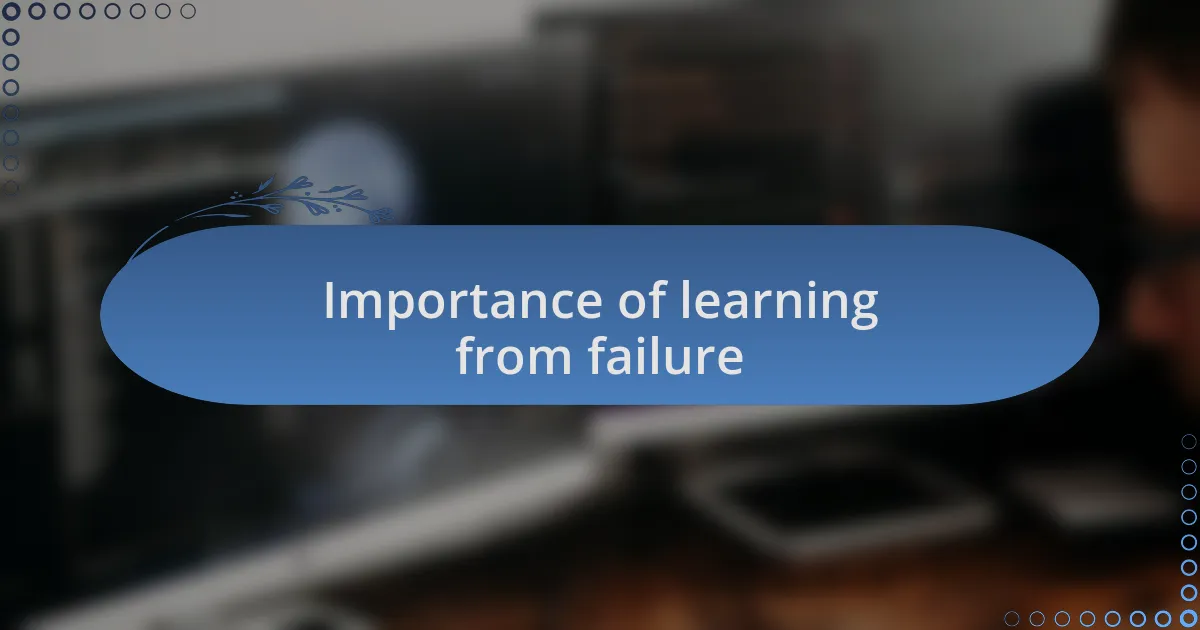
Importance of learning from failure
Learning from failure is essential because it offers valuable insights that success often masks. After a campaign that didn’t resonate, I took a deep dive into our data and realized we hadn’t fully grasped the evolving needs of our audience. Could our assumptions have led us astray? That experience underscored the importance of adapting to feedback; it taught me that insights gained from failure can sharpen our future strategies.
Emotional responses to failure can be tough, but they are also catalysts for growth. I vividly remember the frustration of seeing my own carefully crafted messaging go unheard, only to later uncover that our tone simply didn’t align with our audience’s expectations. How often do we overlook the nuances in communication? Embracing those emotions transformed my perspective, pushing me to be more empathetic and intentional in my subsequent campaigns.
Reflecting on past missteps fosters resilience in the face of adversity. When I saw a campaign fail due to inadequate market research, it prompted me to rethink our entire approach. Isn’t it fascinating how a single setback can propel us forward? Each failure serves as a stepping stone toward greater awareness, driving thoughtful discussions not just about what went wrong, but how to innovate and improve moving forward.
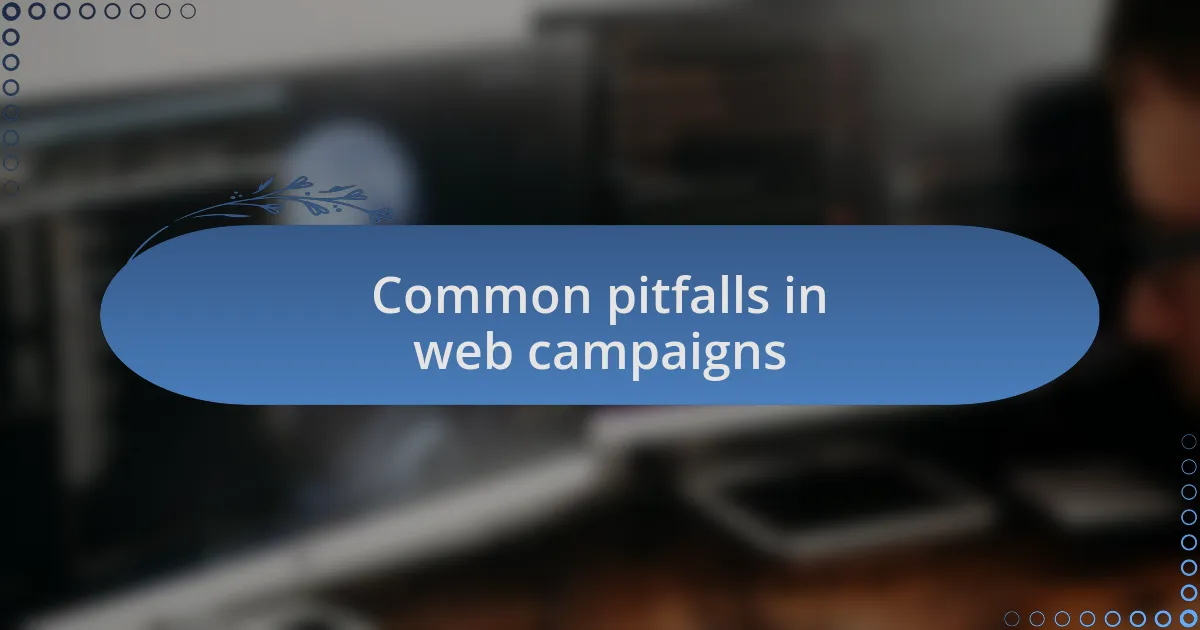
Common pitfalls in web campaigns
One of the most common pitfalls in web campaigns is neglecting the importance of clear objectives. I recall one project where we set out to boost engagement but lacked specific targets. It was disheartening to pour resources into content that didn’t generate meaningful connections. Have you ever experienced that moment of confusion when the metrics just don’t align with your efforts? It’s a stark reminder that without defined goals, our campaigns can easily lose direction.
Another frequent misstep is failing to adapt our strategies mid-campaign. I once launched an initiative based on initial feedback, only to realize halfway through that our audience’s preferences had shifted. Watching the metrics decline was tough, and it forced me to confront the reality that being flexible is crucial. How often do we cling to a plan even when it’s clearly not working? A willingness to pivot can not only salvage a campaign but can also highlight our commitment to our audience’s needs.
Lastly, underestimating the role of analytics can be a major setback. In one instance, we ignored vital data points because we felt confident in our creative direction. The disappointment of seeing low conversion rates was a wake-up call. I learned that numbers aren’t just figures on a screen; they tell a story about what resonates and what falls flat. Have you taken a moment to dive into your analytics? That deep understanding can make all the difference in steering a campaign toward success.
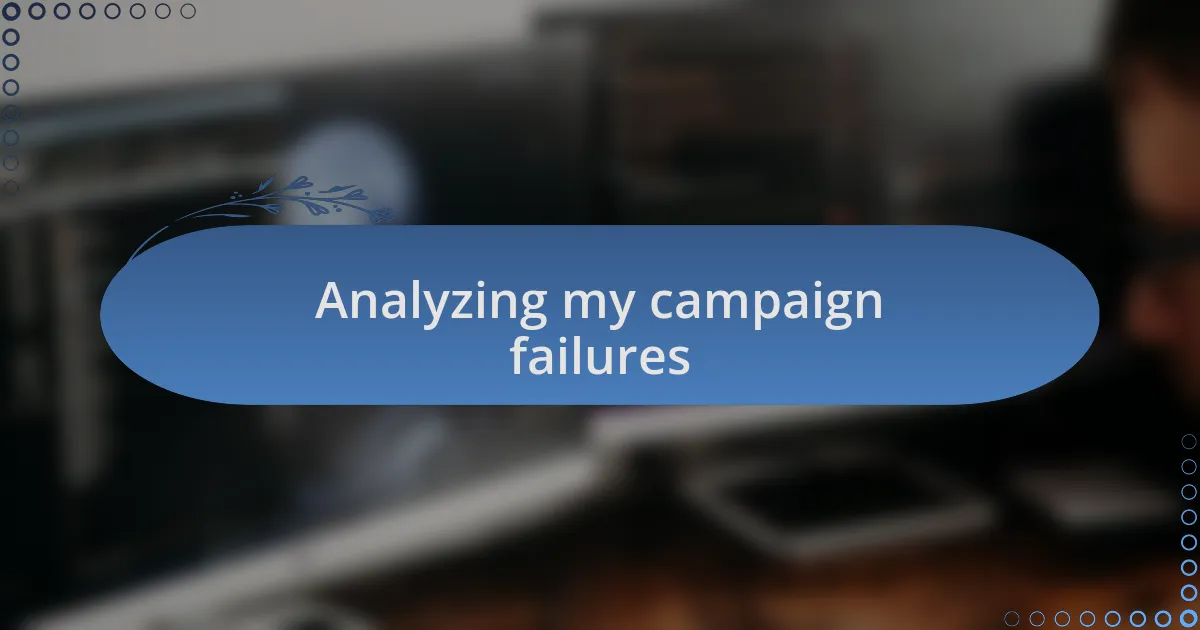
Analyzing my campaign failures
When I reflect on my failed campaigns, one lesson stands out: assumptions can lead us astray. I remember launching a campaign without thoroughly researching our audience’s preferences. It felt like throwing spaghetti at the wall and hoping something would stick. Why did I think I could guess what they wanted? That experience made it clear that real insights come from listening, not guessing.
Another major hurdle I encountered was the impact of inconsistent messaging. I once crafted a vibrant social media campaign that completely clashed with the muted tone of our website. The disconnect was jarring, and I watched as potential customers disengaged, perhaps confused about our brand identity. Have you ever had a moment where you realize your message isn’t landing? It’s a tough pill to swallow, but it underscored the importance of a cohesive narrative across all platforms.
Finally, the struggle with timing proved to be a key factor in some of my campaign failures. I rolled out an idea that I was passionate about, only to find it didn’t align with the season or current events. The lack of relevance left my audience unmoved. Have you thought about how timing affects engagement? I learned that syncing campaigns with the right moments can significantly boost impact, making the effort feel truly worthwhile.
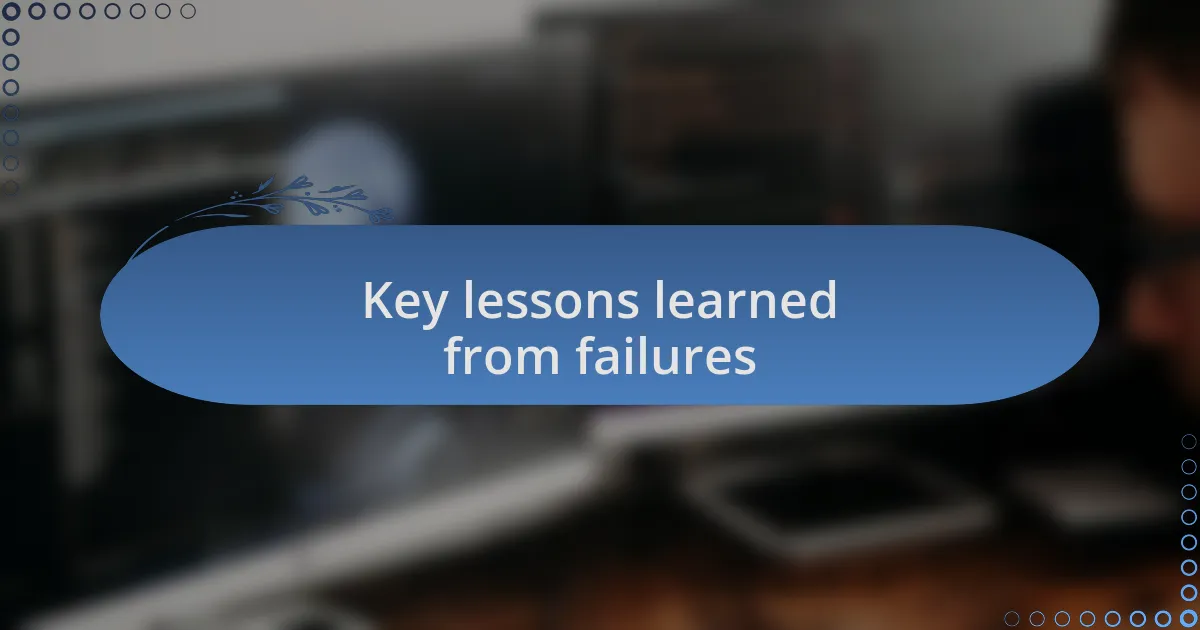
Key lessons learned from failures
The first lesson I learned is that neglected follow-up can derail even the most promising campaigns. I once launched a product that received positive initial interest, but I failed to follow up with potential customers. Days turned into weeks, and the excitement faded. I realized that maintaining engagement didn’t just require a good launch; it needed nurturing and consistent communication to turn interest into action. Have you ever let a golden opportunity slip because you didn’t keep the conversation going?
Another stark reminder from my past failures revolves around the consequences of a poorly defined target audience. I vividly recall creating a compelling ad that I thought would resonate well with tech-savvy young adults, only to discover it appealed more to retirees. The disconnect was not just frustrating; it felt like speaking a different language altogether. This experience taught me that understanding your audience is crucial. Have you ever tailored a message, only to find it completely missed the mark? Developing clear audience personas can transform how campaigns are crafted and executed.
Lastly, I encountered the power of feedback—or, more specifically, the cost of overlooking it. One campaign, filled with my excitement, was met with criticism that I initially brushed off. In hindsight, I realize that feedback is a gift, not a setback. Ignoring those insights only widened the gap between my intention and my audience’s perception. Have you found value in feedback even when it stings? Embracing constructive criticism can lead to healthier campaigns and deeper audience connections.
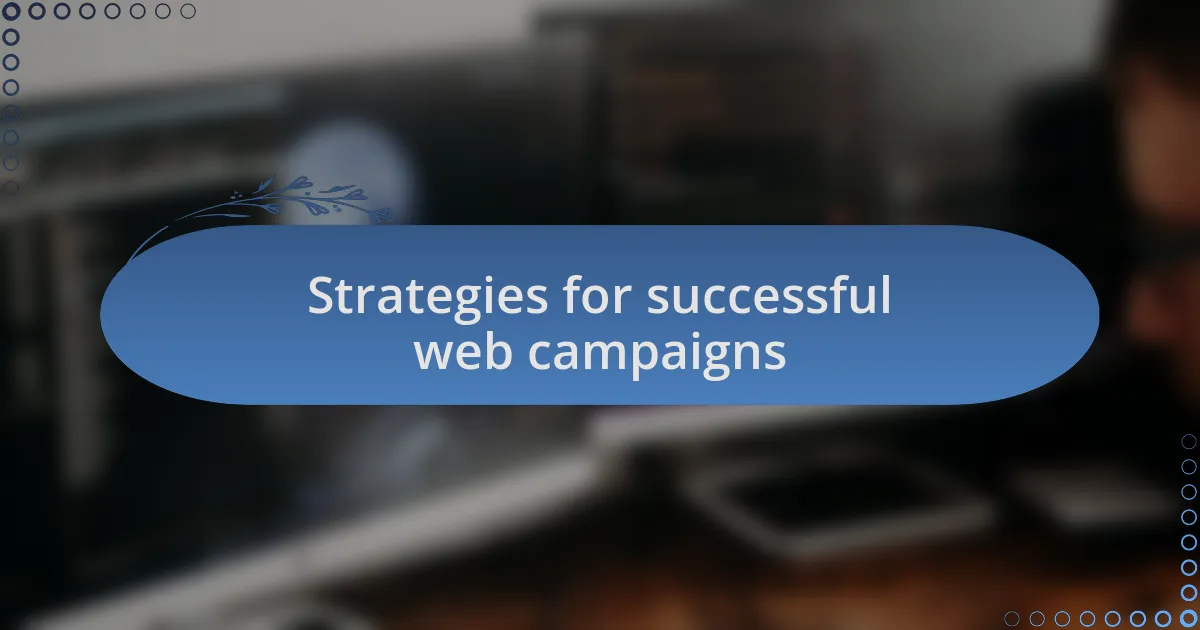
Strategies for successful web campaigns
Developing a clear call-to-action (CTA) is crucial for transforming interest into measurable results. There was a time when I launched a campaign that was visually stunning but lacked a strong directive for the audience. I vividly remember watching the engagement numbers trickle in with disappointment. It wasn’t until I refined my CTA to be more inviting and specific that I noticed a dramatic shift. Have you ever felt the frustration of having all the right elements but lacking that final push to guide your audience? A concise and compelling CTA bridges that gap, driving the action you want.
Another strategy I found invaluable is testing and iterating. In one of my earlier campaigns, I experimented with various headlines and images through A/B testing. The difference in engagement was astounding! I was reminded that what I think resonates with my audience is not always accurate. Involving data-driven decisions allows for continuous improvement. Have you ever hesitated to tweak your approach, thinking your first shot was good enough? Embracing a culture of testing can lead to discoveries that position your campaigns for success.
Lastly, collaborating with cross-functional teams can illuminate insights that might otherwise slip through the cracks. I recall a campaign where insights from the sales team significantly enhanced our strategy—they understood our customers’ pain points in ways I hadn’t considered. This collaboration not only enriched the campaign but also fostered a sense of unity within the organization. How often do you engage with other departments for a fresh perspective? Combining diverse viewpoints can lead to richer, more effective campaigns that resonate deeply with your audience.
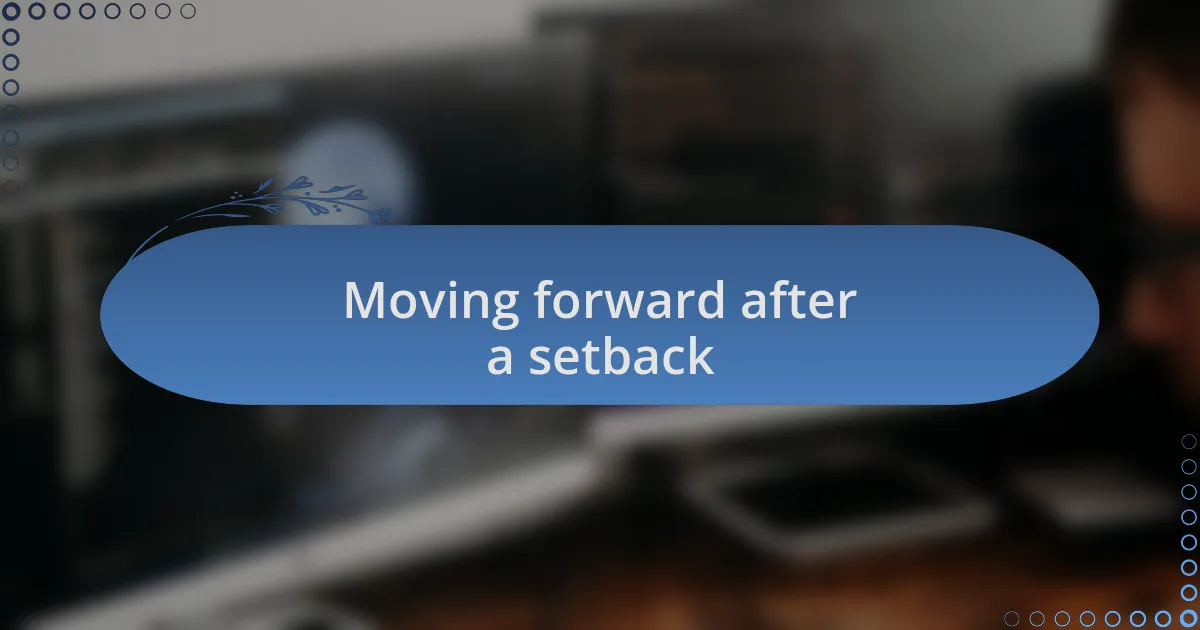
Moving forward after a setback
After experiencing a setback, it’s essential to take a moment to reflect on what went wrong. I remember a campaign that fell flat despite my high hopes. Initially, I was frustrated and disheartened, but I soon realized that this setback wasn’t a dead end; it was an opportunity to analyze my missteps and grow. How often do we let disappointment cloud our vision of potential opportunities?
Once I gathered my thoughts, I shifted my focus toward learning. I made a list of what didn’t resonate with my audience, exploring why my message missed the mark. In these moments, I found that vulnerability can be a strength—acknowledging where I went wrong made me more resilient. Have you ever stopped to think about how your failures can pave the way for future success?
Moving forward, I adopted a proactive mindset. Instead of shrinking back, I leaned into new ideas and sought feedback from trusted peers. I clearly recall seeking advice from a mentor who had navigated similar waters, and their insights sparked a new approach that reinvigorated my campaigns. Engaging with others not only opened my eyes to fresh perspectives but also made me feel more connected and less isolated. What steps can you take to turn your recent challenges into powerful lessons?